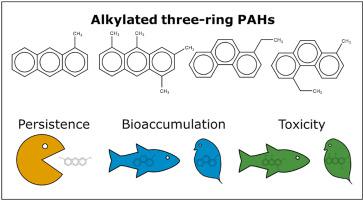Chemosphere ( IF 8.8 ) Pub Date : 2021-02-26 , DOI: 10.1016/j.chemosphere.2021.130113 Pim N.H. Wassenaar , Eric M.J. Verbruggen

|
Substances with (very) persistent, (very) bioaccumulative, and/or toxic properties (PBT/vPvB) are of environmental concern and are identified via hazard-based PBT-assessment approaches. The PBT-assessment of well-defined substances is optimized over the past decades, but is under development for substances of unknown or variable composition, complex reaction products or biological materials (UVCBs). Particularly, the large number of constituents and variable composition complicate the PBT-assessment of UVCBs. For petroleum UVCBs, the use of the hydrocarbon block method (HBM) is proposed. Within this method, groups of constituents with similar physicochemical properties and structure are treated as a single entity and are expected to have comparable environmental fate and hazard properties. So far, however, there is a lack of experience with the application of the HBM for PBT-assessment purposes. The aim of this study is to investigate the suitability of the HBM for the PBT-assessment of petroleum UVCBs by evaluating the group of alkylated three-ring polycyclic aromatic hydrocarbons (PAHs). The presented approach is based on experimental data and model predictions and followed the guidelines of the European Chemicals Agency. Because of a lack of relevant experimental data, relative trend analyses were applied. The results indicate that alkylated three-ring PAHs are more persistent, bioaccumulative, and toxic than the parent three-ring PAHs. As the parent three-ring PAHs are currently identified within Europe as PBT/vPvB substances, the alkylated three-ring PAHs could also be considered as PBT/vPvB. Accordingly, this case study provides the prospects for the application of the HBM for the PBT-assessment of UVCBs using trend analysis.
中文翻译:

石油UVCB的持久性,生物累积和毒性评估:以烷基化三环多环芳烃为例
具有(非常)持久性,(非常)生物蓄积性和/或毒性特性(PBT / vPvB)的物质与环境有关,并通过基于危害的PBT评估方法进行鉴定。定义明确的物质的PBT评估在过去几十年中得到了优化,但是针对未知或可变组成的物质,复杂的反应产物或生物材料(UVCB)仍在开发中。特别是,大量的成分和可变的成分使UVCB的PBT评估复杂化。对于石油UVCB,建议使用烃嵌段法(HBM)。在这种方法中,具有相似物理化学性质和结构的成分组被视为一个整体,并有望具有可比的环境归宿和危害性质。到目前为止,缺乏将HBM用于PBT评估目的的经验。这项研究的目的是通过评估烷基化的三环多环芳烃(PAHs)组来研究HBM对石油UVCB进行PBT评估的适用性。提出的方法基于实验数据和模型预测,并遵循了欧洲化学品管理局的指导原则。由于缺乏相关的实验数据,因此进行了相对趋势分析。结果表明,烷基化的三环PAHs比母体的三环PAHs更持久,具有生物蓄积性和毒性。由于在欧洲目前将母体三环PAHs鉴定为PBT / vPvB物质,因此烷基化的三环PAHs也可以视为PBT / vPvB。因此,



























 京公网安备 11010802027423号
京公网安备 11010802027423号